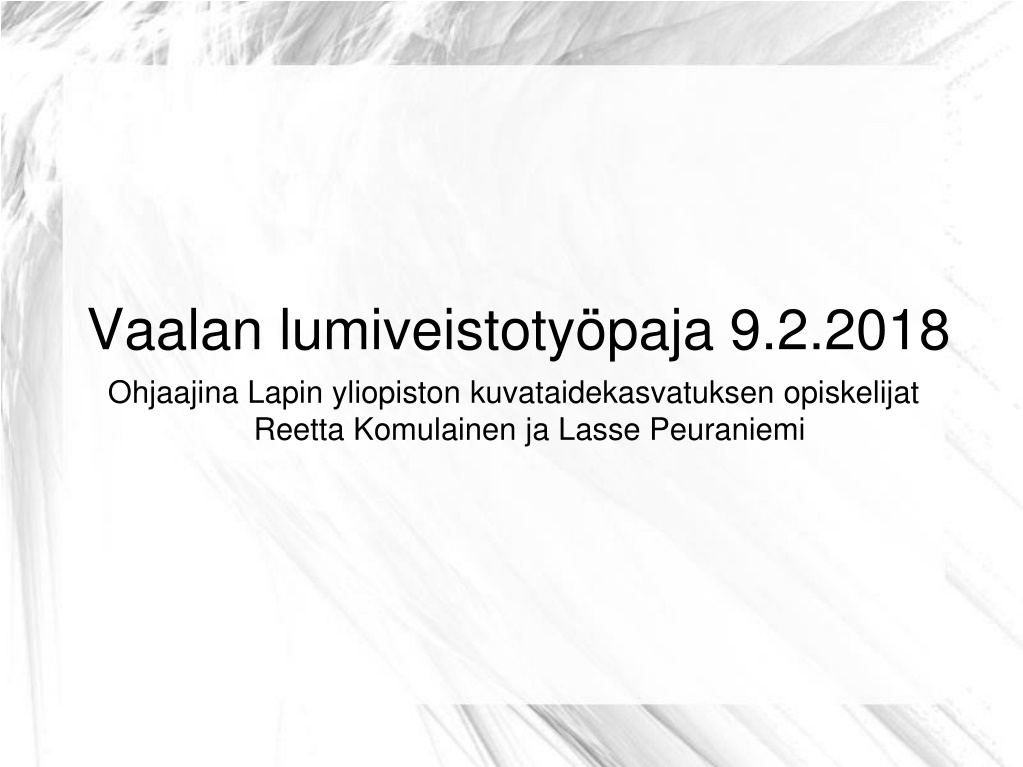Lumiveiston Työvaiheet: Suunnittelusta Veistoksen Hahmotukseen ja Käsittelyyn
Lumiveistoksen luominen alkaa suunnittelusta ja pienoismallin tekemisestä, jatkuu lumiaihion valmistukseen ja veistoksen hahmotteluun. Seuraavaksi lumen karkea työstäminen vie muodon asteittain lopulliseen muotoonsa. Vaihe vaiheelta käydään läpi tarvittavat työvaiheet lumiveistoksen toteuttamiseen.
Download Presentation

Please find below an Image/Link to download the presentation.
The content on the website is provided AS IS for your information and personal use only. It may not be sold, licensed, or shared on other websites without obtaining consent from the author. Download presentation by click this link. If you encounter any issues during the download, it is possible that the publisher has removed the file from their server.
E N D
Presentation Transcript
Vaalan lumiveistotypaja 9.2.2018 Ohjaajina Lapin yliopiston kuvataidekasvatuksen opiskelijat Reetta Komulainen ja Lasse Peuraniemi
1.Suunnittelu ja pienoismallin tekeminen Lumiveistoksen toteuttaminen alkaa ideoinnilla ja paikan valinnalla. On pohdittava, miten lumiveistos sopeutuu paikkaan kokonsa ja muotokielens puolesta ja valaisevatko katulamput tai pihavalot veistoksia. Lis ksi on varmistettava, ett veistokset eiv t ole tilan k yt n esteen . Suunnitteluun ryhdyt n luonnostellen ja pienoismallia hahmotellen. Pienoismallin valmistus auttaa hahmottamaan veistoksen kolmiulotteisena kappaleena. Sen ty st ss voi orientoitua lumiveiston tekniikkaan, eli massan poistamiseen sahaten ja veist en. Pienoismallin voi tehd muovailuvahasta tai plastoliinista, savesta, rautalangasta ja paperista, styroksista, polyuretaanista tai vaikkapa puupalikoista. Pienoismallin materiaalin valinnalla voi tukea lumiveistoksen ideaa. Onko tarkoituksena ty st pelkistettyj pintoja vai esitt vi hahmoja tai kulmikkaita vai py reit muotoja? Polyuretaani, kipsi ja rakentelupalikat soveltuvat pelkistettyjen muotojen hahmotteluun. Savi ja muovailuvaha soveltuvat puolestaan tarkkaan ja plastiseen muotoiluun. Pakkasella savimallit j tyv t ulkona ja sen takia muovailuvahamalli on savimallia k yt nn llisempi.
2. Lumiaihion valmistaminen Kun lumiveistos on suunniteltu, on pohdittava, millaisella lumimuotilla aihio kannattaa rakentaa. Yleisimmin k yt ss oleva veistomuotti on puurimoilla tuettu filmivanerilevy, jonka nelj sein voidaan liitt yhteen esimerkiksi lukoilla tai ruuveilla. Isojen lumiaihioiden valmistaminen vaatii t llaisen puisen tai metallilevyst rakennetun muotin. Kun lumiaihio valmistetaan k sivoimin, muottiin lapioidaan lunta, joka poljetaan tiiviiksi parinkymmenen senttimetrin kerroksissa. Tiivist minen kannattaa tehd huolellisesti, jotta aihio ei lumen tiivistyess itsest n muuttaisi muotoaan esimerkiksi kallistumalla. Muotti voidaan irrottaa heti, kun se on t ytetty kokonaan. Aluksi aihio on hyvin pehme , mutta se kovettuu parhaimmilleen yhden y n aikana.
3. Veistoksen hahmottelu Lumiaihioiden jokaiselle sivulle merkit n p linjat kovertaen, merkkitikuilla tai spraymaalilla. Isossa veistoksessa suorat linjat l ytyv t liitulangalla merkitsem ll .
4. Karkea tyst Lunta poistetaan merkint jen mukaan karkeilla ty v lineill , kuten sahalla, lapiolla tai petkeleell . Jos aihio on hyvin iso, ty st minen aloitetaan yl osasta, josta edet n alasp in. Nyt veistoksen muoto alkaa hahmottua. Ymp rille kasaantuva irtolumi kannattaa kolata pois, ennen kuin sen tallautuu maahan kiinni.
4. Hienotyst ja viimeistely Lopuksi ty stet n veistoksen yksityiskohdat pienill sahoilla, taltoilla ja raspeilla. My s veistoksen pinnat viimeistell n taltoilla tai raspeilla. Pintojen ty st on usein suurin ty , mutta viimeistelty lopputulos palkitsee huolellisen ty skentelij n. Lopulta teos on valmis, kun sen ymp rist kin on kolattu ja siistitty.
Vaala Snow Sculpture Workshop 9.2.2018 Directors: Art Education students from Lapland University, Reetta Komulainen & Lasse Peuraniemi
1. Designing and Making a Scale Model Making a snow sculpture starts with brainstorming and choosing the site. It is important to consider the size and design of the sculpture in relation to the site as well as possible light from street or yard lamps. Sculptures should also be placed so that they don't obstruct traffic visibility or come in the way of maintenance trucks. The design starts with sketches and a scale model. A model can be made from modeling clay or Plasticine, paper and wire, Styrofoam, polyurethane (a light, Styrofoam-like material that is easy to saw into simple shapes), or even wooden blocks, etc. Since it doesn't freeze, modeling clay is better suited for below-zero temperatures than natural clay. The choice of the material for the model can support the idea of the snow sculpture itself, whether it utilizes simplified, sharp, or soft forms. Polyurethane, plaster, and wooden blocks are suitable for simplified forms, while clay and modeling clay are good for detailed and plastic designs.
2. Packing a Block of Snow Once the sculpture has been designed, a mold must be chosen. Usually molds are made of plywood and reinforced with laths, with the corners connected with locks or screws. A wooden or metal mold is essential when making large blocks of snow. To make a snow block by hand, snow is shoveled into the mold in 20-centimeter layers and packed tight after each layer. This must be done carefully so that the mold doesn't start leaning on one side. The mold can be taken off immediately after the snow is packed. At first the block is very soft, but it will harden overnight.
3. Outlining a Sculpture On each side of the preform the outlines are carved or marked with sticks or spray paint. In a large sculpture the straight lines can be marked with chalk line.
5. Fine Sculpting and Finishing Touches Finally, the details of the sculpture are completed using small saws, chisels, and files. Chisels and files are also used for giving the surfaces a finishing touch. This is usually the most time-consuming part, requiring painstaking concentration, but the reward is a beautifully finished sculpture. The work is finally done when its surroundings are tidied up as well.
4. Rough Sculpting Snow is removed along the marked outlines using rough tools such as saws, shovels, or chopping knives. If the block is very large, the sculpting should be started from the top part. As the shape of the sculpture begins to come out, the snow on the ground should be shoveled away before it gets packed on the ground.

